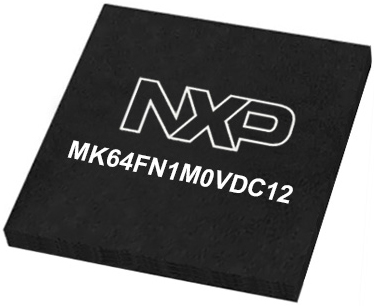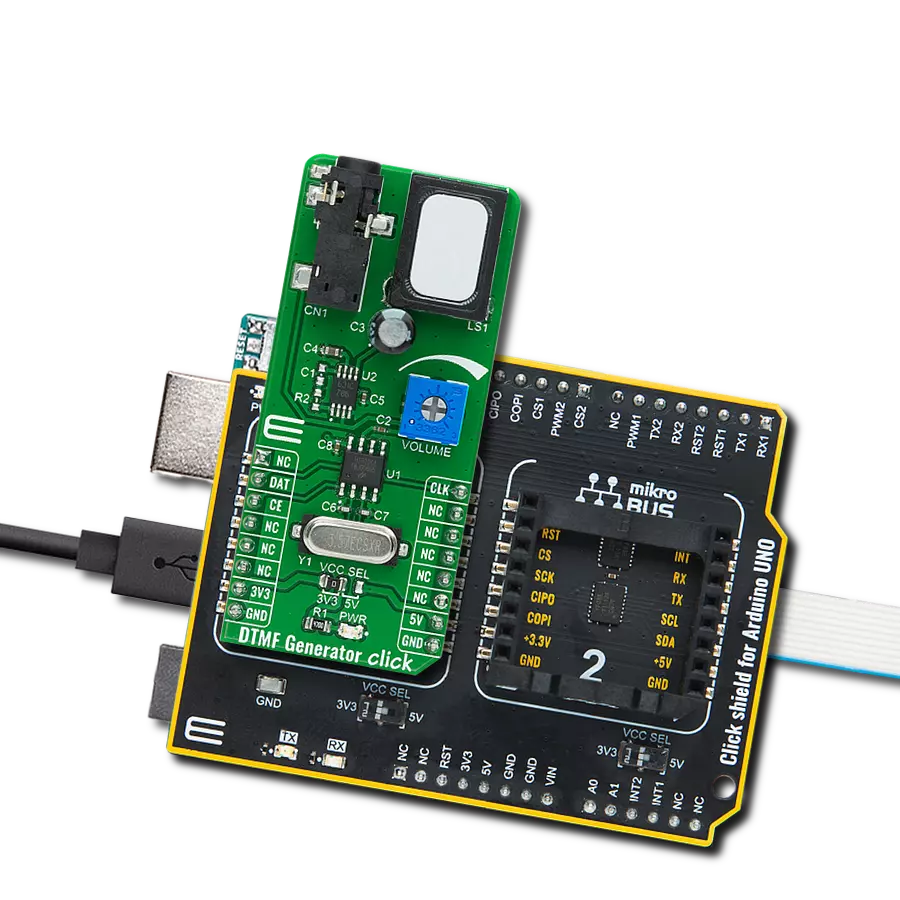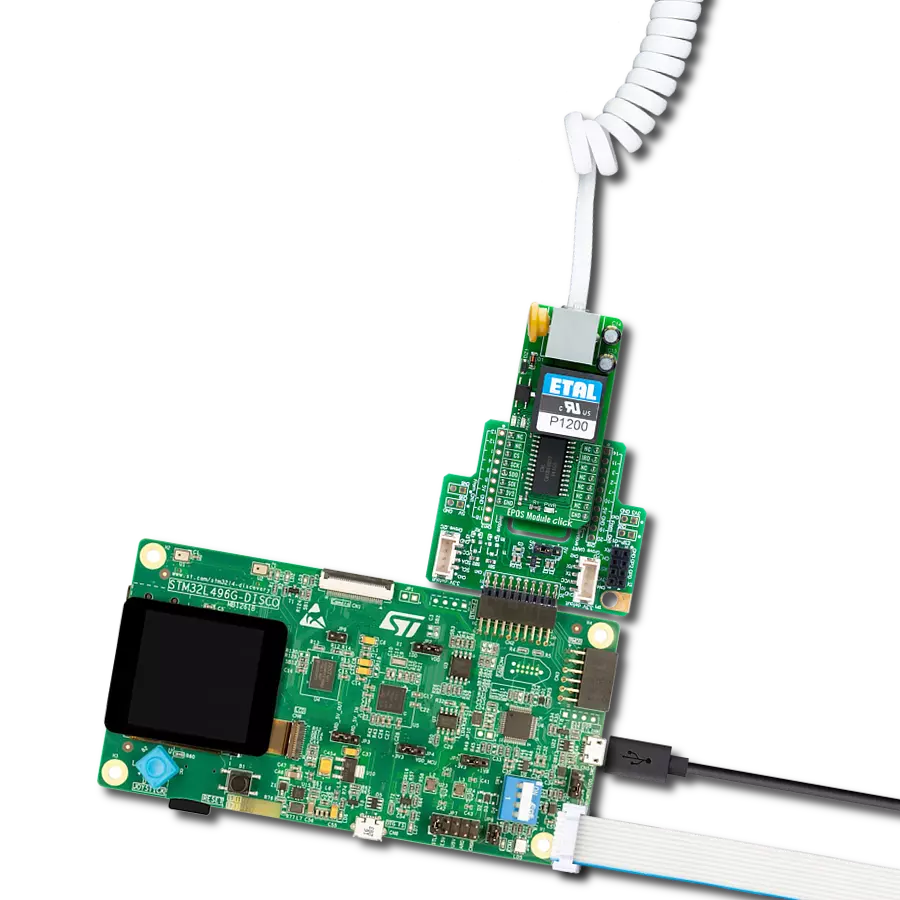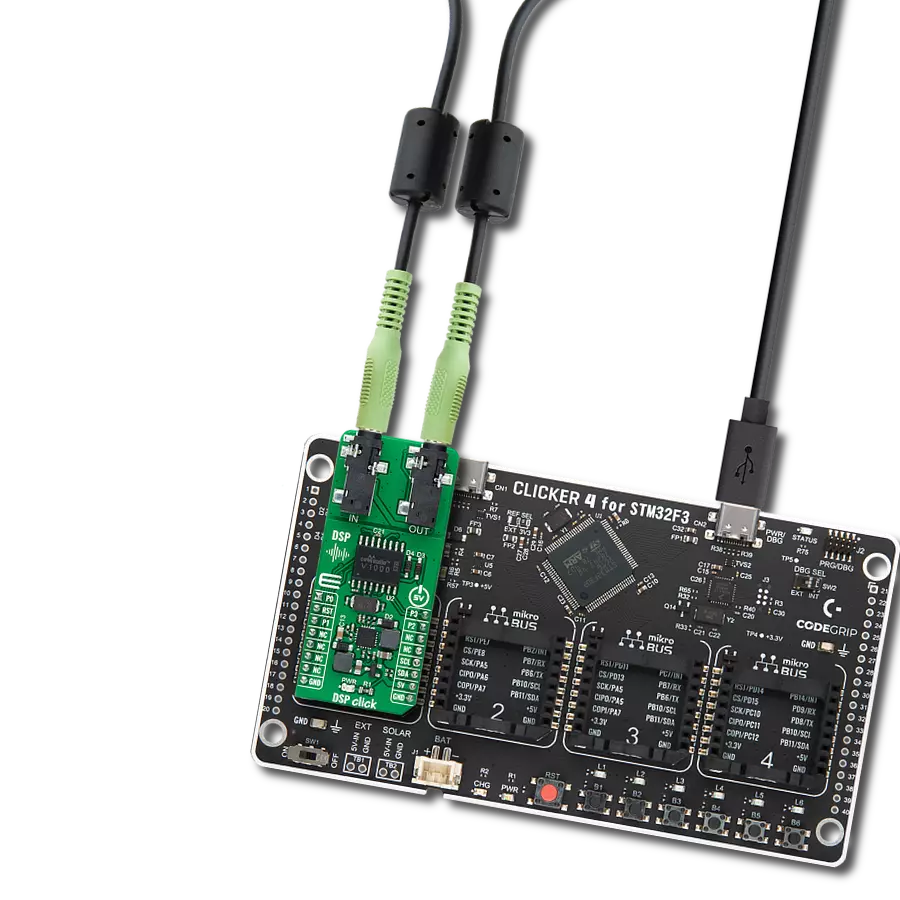启用安全、低功耗的调制解调器通信,适用于EPOS终端和远程系统,在工业控制和安全应用中实现可靠的数据传输
A
A
硬件概览
它是如何工作的?
EPOS Module Click基于CML Micro的CMX869B多标准v.32 bis调制解调器,支持多种协议,并提供低功耗设计。这款低功耗调制解调器解决方案专为EPOS(电子销售点)终端和电话系统等应用而设计。CMX869B支持ITU V.32 bis、V.22 bis、V.22、V.21和Bell 202及103等标准,适用于多种通信场景。其数据传输速率可达14.400bps,并支持自动降级至4.800bps,具备重协商速率重新训练和自动检测V.22及V.22 bis调制解调器的功能。此Click板™非常适用于EPOS终端、电话遥测系统、远程公用事业抄表、安防系统、工业控制等应用。除了强大的调制解调器
功能,CMX869B还包括高质量的DTMF(双音多频)编码器和解码器,适合管理电话系统中的呼叫信令和检测。调制解调器还可以传输和检测用户编程的单音和双音信号,并处理调制解调器的呼叫和应答音,确保兼容各种专有通信协议,超越标准调制解调器操作。该Click板™提供完全隔离的EPOS/电话连接,内置的P1200变压器确保平稳通信,同时提供完整的电气隔离。CMX869B与主MCU之间的数据和控制交换通过C-BUS接口进行,兼容mikroBUS™插座的标准4线SPI接口。该板还使用mikroBUS™插座上的IRQ引脚,用于处理呼叫状态(如忙碌、拨号和连接状态)
相关的中断请求。红色RING LED指示振铃信号,蓝色HOOK LED作为摘挂机指示灯,用于管理线路接口的连接状态(0-关闭,1-打开)。CMX869B的另一个特点是Powersave模式,它通过停用除必要的C-BUS(SPI)接口以外的所有电路来节约能源。此Click板™只能在3.3V逻辑电平下运行。在使用具有不同逻辑电平的MCU之前,必须进行适当的逻辑电平转换。此外,该Click板™还配备了包含易于使用的函数和示例代码的库,可作为进一步开发的参考。
功能概述
开发板
Clicker 2 for Kinetis 是一款紧凑型入门开发板,它将 Click 板™的灵活性带给您喜爱的微控制器,使其成为实现您想法的完美入门套件。它配备了一款板载 32 位 ARM Cortex-M4F 微控制器,NXP 半导体公司的 MK64FN1M0VDC12,两个 mikroBUS™ 插槽用于 Click 板™连接,一个 USB 连接器,LED 指示灯,按钮,一个 JTAG 程序员连接器以及两个 26 针头用于与外部电子设备的接口。其紧凑的设计和清晰、易识别的丝网标记让您能够迅速构建具有独特功能和特性
的小工具。Clicker 2 for Kinetis 开发套件的每个部分 都包含了使同一板块运行最高效的必要组件。除了可以选择 Clicker 2 for Kinetis 的编程方式,使用 USB HID mikroBootloader 或外部 mikroProg 连接器进行 Kinetis 编程外,Clicker 2 板还包括一个干净且调节过的开发套件电源供应模块。它提供了两种供电方式;通过 USB Micro-B 电缆,其中板载电压调节器为板上每个组件提供适当的电压水平,或使用锂聚合物 电池通过板载电池连接器供电。所有 mikroBUS™ 本
身支持的通信方法都在这块板上,包括已经建立良好的 mikroBUS™ 插槽、重置按钮和几个用户可配置的按钮及 LED 指示灯。Clicker 2 for Kinetis 是 Mikroe 生态系统的一个组成部分,允许您在几分钟内创建新的应用程序。它由 Mikroe 软件工具原生支持,得益于大量不同的 Click 板™(超过一千块板),其数量每天都在增长,它涵盖了原型制作的许多方面。
微控制器概述
MCU卡片 / MCU

建筑
ARM Cortex-M4
MCU 内存 (KB)
1024
硅供应商
NXP
引脚数
121
RAM (字节)
262144
使用的MCU引脚
mikroBUS™映射器
“仔细看看!”
Click board™ 原理图

一步一步来
项目组装
实时跟踪您的结果
应用程序输出
1. 应用程序输出 - 在调试模式下,“应用程序输出”窗口支持实时数据监控,直接提供执行结果的可视化。请按照提供的教程正确配置环境,以确保数据正确显示。

2. UART 终端 - 使用UART Terminal通过USB to UART converter监视数据传输,实现Click board™与开发系统之间的直接通信。请根据项目需求配置波特率和其他串行设置,以确保正常运行。有关分步设置说明,请参考提供的教程。

3. Plot 输出 - Plot功能提供了一种强大的方式来可视化实时传感器数据,使趋势分析、调试和多个数据点的对比变得更加直观。要正确设置,请按照提供的教程,其中包含使用Plot功能显示Click board™读数的分步示例。在代码中使用Plot功能时,请使用以下函数:plot(insert_graph_name, variable_name);。这是一个通用格式,用户需要将“insert_graph_name”替换为实际图表名称,并将“variable_name”替换为要显示的参数。

软件支持
库描述
该库包含 EPOS Module Click 驱动程序的 API。
关键功能:
eposmodule_handshake_init- 此函数执行握手初始化,将设备设置重置为默认值。eposmodule_dial- 此函数通过在双音多频(DTMF)和无音之间交替拨打所选号码。eposmodule_send_message- 此函数通过V.23 FSK 1200bps调制解调器以起停8.1模式发送字节数组。
开源
代码示例
完整的应用程序代码和一个现成的项目可以通过NECTO Studio包管理器直接安装到NECTO Studio。 应用程序代码也可以在MIKROE的GitHub账户中找到。
/*!
* @file main.c
* @brief EPOS Module Click example
*
* # Description
* This example demonstrates the use of EPOS Module Click board by showing
* the communication between the two Click boards connected to PBX system.
*
* The demo application is composed of two sections :
*
* ## Application Init
* Initializes the driver and logger, and displays the selected application mode.
*
* ## Application Task
* Dialing application mode:
* - Resets the device settings and dials the selected number. If a call is answered
* it starts sending desired messages every couple of seconds with constantly checking
* if a call is still in progress or it's terminated from the other side.
* Answering application mode:
* - Resets the device settings and waits for an incoming call indication, answers the call,
* and waits for a desired number of messages. The call is terminated after all messages
* are received successfully.
*
* @note
* We have used a Yeastar S20 VoIP PBX system for the test, where the Click boards are
* connected to ports 1 and 2 configured as FXS extension with numbers 1000 and 1001 (dialer).
*
* @author Stefan Filipovic
*
*/
#include "board.h"
#include "log.h"
#include "eposmodule.h"
// Demo aplication selection macros
#define APP_DIALING 0
#define APP_ANSWERING 1
#define DEMO_APP APP_DIALING
// Dialing application settings - a dial number and text to send (must end with CRLF - \r\n)
#define DIAL_NUMBER "1000"
#define TEXT_TO_SEND "MIKROE - EPOS Module Click\r\n"
// Answering application settings - a number of successfully received messages before call termination
#define NUM_MESSAGES 5u
static eposmodule_t eposmodule;
static log_t logger;
void application_init ( void )
{
log_cfg_t log_cfg; /**< Logger config object. */
eposmodule_cfg_t eposmodule_cfg; /**< Click config object. */
/**
* Logger initialization.
* Default baud rate: 115200
* Default log level: LOG_LEVEL_DEBUG
* @note If USB_UART_RX and USB_UART_TX
* are defined as HAL_PIN_NC, you will
* need to define them manually for log to work.
* See @b LOG_MAP_USB_UART macro definition for detailed explanation.
*/
LOG_MAP_USB_UART( log_cfg );
log_init( &logger, &log_cfg );
log_info( &logger, " Application Init " );
// Click initialization.
eposmodule_cfg_setup( &eposmodule_cfg );
EPOSMODULE_MAP_MIKROBUS( eposmodule_cfg, MIKROBUS_1 );
if ( SPI_MASTER_ERROR == eposmodule_init( &eposmodule, &eposmodule_cfg ) )
{
log_error( &logger, " Communication init." );
for ( ; ; );
}
#if ( DEMO_APP == APP_DIALING )
log_printf( &logger, " Application Mode: Dialing\r\n" );
#elif ( DEMO_APP == APP_ANSWERING )
log_printf( &logger, " Application Mode: Answering\r\n" );
#else
#error "Selected application mode is not supported!"
#endif
log_info( &logger, " Application Task " );
}
void application_task ( void )
{
uint8_t state = EPOSMODULE_STATE_IDLE;
uint32_t time_cnt = 0;
uint8_t msg_cnt = 0;
eposmodule_handshake_init ( &eposmodule );
#if ( DEMO_APP == APP_DIALING )
log_printf( &logger, "\r\n Hook OFF\r\n" );
eposmodule_hook_off ( &eposmodule );
Delay_ms ( 1000 );
Delay_ms ( 1000 );
Delay_ms ( 1000 );
Delay_ms ( 1000 );
log_printf( &logger, " Dial: %s\r\n", ( char * ) DIAL_NUMBER );
eposmodule_dial ( &eposmodule, DIAL_NUMBER );
eposmodule.rx_mode &= EPOSMODULE_RX_LEVEL_MASK; // No change in rx level setting
eposmodule.rx_mode |= ( EPOSMODULE_RX_MODE_DTMF_TONES | EPOSMODULE_RX_TONE_DETECT_CALL_PROG );
eposmodule_set_receive_mode ( &eposmodule, eposmodule.rx_mode );
for ( ; ; )
{
Delay_ms ( 1 );
if ( !eposmodule_get_irq_pin ( &eposmodule ) )
{
time_cnt = 0;
state = EPOSMODULE_STATE_IRQ_SET;
}
if ( ( EPOSMODULE_STATE_IRQ_SET == state ) && !eposmodule_call_progress ( &eposmodule ) )
{
if ( time_cnt < EPOSMODULE_TIMING_BUSY )
{
log_printf( &logger, " Busy\r\n" );
break;
}
else if ( time_cnt < EPOSMODULE_TIMING_DISCONNECTED )
{
log_printf( &logger, " Disconnected\r\n" );
break;
}
else if ( time_cnt < EPOSMODULE_TIMING_RINGING )
{
log_printf( &logger, " Ringing\r\n" );
state = EPOSMODULE_STATE_RINGING;
}
}
if ( ( EPOSMODULE_STATE_RINGING == state ) && ( time_cnt > EPOSMODULE_TIMING_CALL_PROGRESS ) )
{
log_printf( &logger, " Call in progress\r\n" );
state = EPOSMODULE_STATE_CALL_IN_PROGRESS;
time_cnt = 0;
}
if ( ( EPOSMODULE_STATE_CALL_IN_PROGRESS == state ) && !( time_cnt % EPOSMODULE_TIMING_SEND_MESSAGE ) )
{
log_printf( &logger, " Send message %u\r\n", ( uint16_t ) msg_cnt++ );
eposmodule_send_message ( &eposmodule, TEXT_TO_SEND, strlen ( TEXT_TO_SEND ) );
}
if ( time_cnt++ > EPOSMODULE_TIMEOUT_CALL_PROGRESS )
{
log_printf( &logger, " Timeout\r\n" );
break;
}
}
log_printf( &logger, " Hook ON\r\n" );
eposmodule_hook_on ( &eposmodule );
Delay_ms ( 1000 );
Delay_ms ( 1000 );
Delay_ms ( 1000 );
Delay_ms ( 1000 );
#elif ( DEMO_APP == APP_ANSWERING )
uint8_t rx_data = 0;
uint8_t msg_end_buff[ 2 ] = { 0 };
log_printf( &logger, "\r\n Waiting for a call...\r\n" );
while ( !eposmodule_ring_detect ( &eposmodule ) );
Delay_ms ( 1000 );
log_printf( &logger, " Hook OFF\r\n" );
eposmodule_hook_off ( &eposmodule );
Delay_ms ( 1000 );
log_printf( &logger, " Waiting for %u messages...\r\n", ( uint16_t ) NUM_MESSAGES );
eposmodule.rx_mode &= EPOSMODULE_RX_LEVEL_MASK; // No change in rx level setting
eposmodule.rx_mode |= ( EPOSMODULE_RX_MODE_V23_FSK_1200 | EPOSMODULE_RX_DATA_FORMAT_SS_NO_OVS |
EPOSMODULE_RX_DATA_PARITY_8_NO_PAR );
eposmodule_set_receive_mode ( &eposmodule, eposmodule.rx_mode );
for ( ; ; )
{
Delay_ms ( 1 );
if ( !eposmodule_get_irq_pin ( &eposmodule ) )
{
if ( EPOSMODULE_STATE_IDLE != state )
{
log_printf( &logger, "\r\n Disconnected\r\n" );
break;
}
log_printf( &logger, " Message %u: ", ( uint16_t ) msg_cnt );
state = EPOSMODULE_STATE_IRQ_SET;
time_cnt = 0;
}
if ( ( EPOSMODULE_STATE_IRQ_SET == state ) && !( time_cnt % EPOSMODULE_TIMING_RX_READY ) )
{
if ( eposmodule_unscram_1s_det ( &eposmodule ) && eposmodule_rx_ready ( &eposmodule ) )
{
eposmodule_receive_data ( &eposmodule, &rx_data );
if ( ( ( ' ' <= rx_data ) && ( '~' >= rx_data ) ) ||
( '\r' == rx_data ) || ( '\n' == rx_data ) )
{
log_printf( &logger, "%c", ( char ) rx_data );
}
if ( '\r' == rx_data )
{
msg_end_buff[ 0 ] = rx_data;
}
else if ( '\n' == rx_data )
{
msg_end_buff[ 1 ] = rx_data;
}
else
{
msg_end_buff[ 0 ] = 0;
msg_end_buff[ 1 ] = 0;
}
}
if ( ( '\r' == msg_end_buff[ 0 ] ) && ( '\n' == msg_end_buff[ 1 ] ) )
{
msg_end_buff[ 0 ] = 0;
msg_end_buff[ 1 ] = 0;
state = EPOSMODULE_STATE_IDLE;
if ( NUM_MESSAGES == ++msg_cnt )
{
Delay_ms ( 100 );
log_printf( &logger, " Terminate call\r\n" );
Delay_ms ( 100 );
break;
}
}
}
if ( time_cnt++ > EPOSMODULE_TIMING_WAIT_FOR_MESSAGE )
{
log_printf( &logger, "\r\n Timeout\r\n" );
break;
}
}
log_printf( &logger, " Hook ON\r\n" );
eposmodule_hook_on ( &eposmodule );
Delay_ms ( 1000 );
Delay_ms ( 1000 );
Delay_ms ( 1000 );
Delay_ms ( 1000 );
#endif
}
int main ( void )
{
/* Do not remove this line or clock might not be set correctly. */
#ifdef PREINIT_SUPPORTED
preinit();
#endif
application_init( );
for ( ; ; )
{
application_task( );
}
return 0;
}
// ------------------------------------------------------------------------ END
































